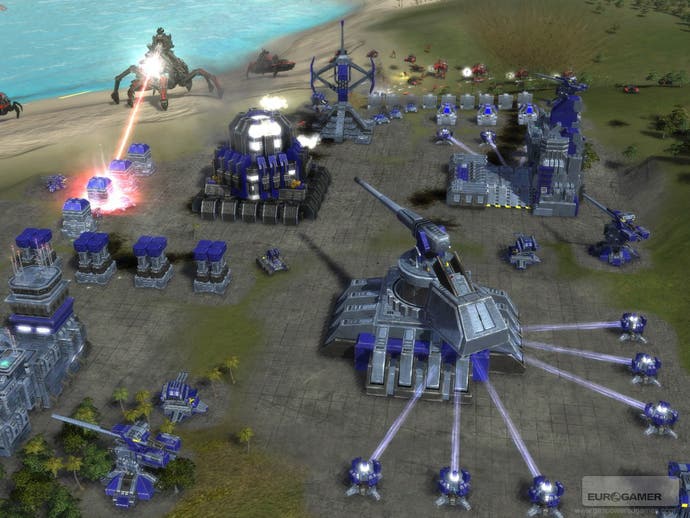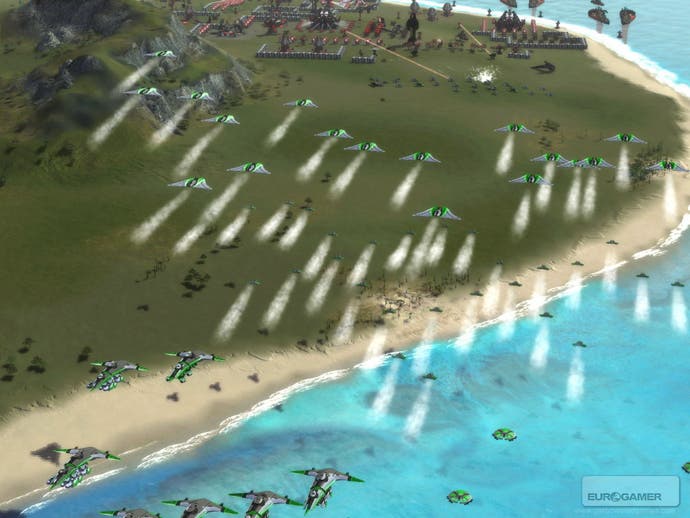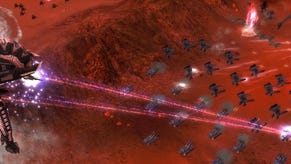Supreme Commander
Alec takes a near-complete build for a spin.
This is the most complicated simple game you'll play in a while. It's the cheerful fling that quickly and quietly becomes something serious, something so intense it's mentally exhausting in all the right ways. Supreme Commander is unashamedly RTS, reduced to the nuts, bolts and panels of bewildering icons that have always defined that most PC of all game genres. Its only pretension is to be really big - it doesn't have Total War's grand strategy map or Company of Heroes' merry gene-splicing of the formula, nor does it need them. It just needs to be huge, and that's where the complexity comes in. Hundreds of units, each with their own handicaps and potencies, maps that'll wear your mouse-arm out to pan entirely across, and constant battles on a good half-dozen different fronts simultaneously. The objective is only ever to kill the other guy, but when there's so much to think about at once, it ain't easy.
I haven't, it must be said, orchestrated a great many real wars (save, perhaps, for an unsuccessful attempt at igniting tensions between a guinea pig and a rabbit). My time with pre-release code of Supreme Commander has me convinced, though, there's something genuine in its evocation of the mental strain, the panic, the satisfaction, the sadistic glee and the cold detachment of the guy calling the shots. There's such an incredible amount to manage at once that the simplest and in other games most tedious tasks are granted feverish intensity. Nipping to the other side of the map to tell an idling engineer to build another power generator feels like dicing with death when there's a slew of enemy gunships knocking at my front door. And a horde of tanks headed towards a vital forward base. And a fleet of battleships bombarding a coastal factory. And something gigantic and spider-shaped loping slowly from the unknown territory to the south. And... is that a nuke?

Supreme Commander, as you may well know, is the spiritual sequel to RTS legend Total Annihilation. That old dear was the game that first proved that the Command & Conquer approach to real-time strategy wasn't the only or even the best one. News at the time concentrated on how it was the first 3D RTS, but really that was inconsequential. Resource collection and micro-management was stripped down to a bare, self-regulated minimum, in favour of war on a massive scale. It was a phenomenon, recalled with great affection by almost all who played it. But it's a decade old.
Its creator, Chris Taylor, and his current studio Gas-Powered Games, has been off making the look-no-hands Dungeon Siege RPGs for the last few years, but now he's come back to what made him. The Total Annihilation name may rest with Atari (which doesn't look as though it is ever going to do anything with it), but Supreme Commander is definitely TA. Infinite resources, automatically looped building and huge unit counts are still the order of the day. There's no silly lone sniper missions or victory-point capture here - there is only war.
It even looks oddly, charmingly retro, probably because so much of it is harsh angles, gridlines and cubic constructs - almost that image of the future '80s movies depicted. It's actually a spectacular-looking game - zoom right in and its fine selection of robots, tanks, planes, ships and insane experimental machines are intricate and distinct. This detail's almost futile, apart from when you want to savour a sure victory.

A flick downwards of the mouse-wheel takes you up, up and away to a godlike view that much of the game is spent in. It transforms the 3D battlefield into a sort of maximised mini-map, comprised of coloured squares and triangles for you to command or, uh, conquer. Rather than feeling like some rudimentary throwback, it has the detached elegance of, say, Defcon to it - a cold screenful of shapes and colours is, after all, how a general spends his war. He doesn't need to see the faces of the men (or robots) he's sending off to die - he just needs a means to usher them around, obedient ants in a glass tank of death. It's a trick that really works, both for living up to the game's title and for dispensing with that most irksome of RTS stereotypes, the mini-map. There is one in there as an option (defaulted to off), but against the smartly-integrated ultra-bird's-eye-view, it's suddenly obvious that Dune 2 has been an unwelcome guest kipping on the sofa for far too long now.
The rules are different now, in style and in combat. Like Company of Heroes, victory doesn't come from crazy assaults on the enemy base, but rather pushing gradually forwards, forever creeping your front line further across the map, pushing your foe into a corner. And that maps really are massive - send a wing of gunships to the other side and they run out of fuel halfway across. Send a platoon of tanks over and you'll be waiting ten minutes for them to get there, and they'll probably have been airbombed en route anyway.
What really stands out from the preview code (apart from bringing my better-than-average PC to its knees - if there isn't a lot of optimisation come the final game, this will be very much a luxury item) is the challenge of the game. I could put it down to beta version jitters, but the difficulty, the demands on flabby, unexercised bits of my brain that usually slumber through a gaming session, feels absolutely in keeping with the feel of Supreme Commander.

It's not often that single-player AI seems to behave anything like multiplayer opponents, but man, those robots are smart. I'm used to exploiting single-player RTS campaigns, to spotting the bits I can attack so that the game will artificially halt my enemies reinforcing themselves. I'm used to my computer-controlled foes not being capable of much more than a soggy pincer movement. I'm not used to near-constant besiegement, to being flanked, outflanked and sometimes, totally humiliated. It could be there's more leniency in the finished code, and that will give more scope to savour Supreme Commander's big stompy robots and to quickly develop tactics rather than panic reflexes, but I hope not - it's good to be challenged. Long-term, it means the tactics I do develop will be that much more considered, playing to the violently-highlighted strengths and weaknesses of my units rather than just zerging here and hedgehogging there. It's good to have a game aimed, for once, more at folk who've been playing this kind of thing for years.
Hot on the heels on the sublime Company of Heroes, if Supreme Commander can successfully mix its challenge/entertainment cocktail, the PC can finally start to shed its reputation of beardy, identikit RTSes for beardy, identikit men. The reason we all played TA, and even C&C, back in the day was because we had fun playing them, not because the tank modelling was 100 per cent accurate or because there were six types of resources to farm. We're returning, at last, to what made those early ones so fondly-remembered - fighting artfully-arranged wars in which stuff explodes spectacularly.






.png?width=291&height=164&fit=crop&quality=80&format=jpg&auto=webp)



